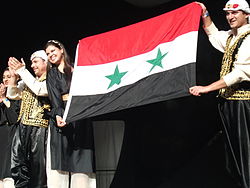| Country | Estimate | Upper Estimate | Region | Country article in English Wikipedia |
|---|
| + | | | | |
|---|
 Brazil Brazil | 1,000,000 according to a research conducted by IBGE in 2008, covering only the states of Amazonas, Paraíba, São Paulo, Rio Grande do Sul, Mato Grosso and Distrito Federal, 0.9% of caucasoid Brazilian respondents said they had family origins in the Middle East [6] | 4,000,000 people of Syrian ancestry (according to Brazilian government) [7] | South America | Syrian Brazilian |
 Turkey Turkey | 3,611,834 registered (December 2018) [8] | | Europe
Asia | Syrians in Turkey |
 Lebanon Lebanon | 950,334 registered (December 2018) [9] | | Middle East | Syrians in Lebanon |
 Jordan Jordan | 671,148 registered (December 2018) [10] | 1,400,000 estimated (August 2015) [11] | Middle East | Syrians in Jordan |
 Germany Germany | 1,281,000 (2023) [12] | | European Union | Syrians in Germany |
 Argentina Argentina | 1,500,000 | 2,000,000 | South America | Syrian Argentine |
 Saudi Arabia Saudi Arabia | 449,314 (2022 census) [13] | 449,000 | Middle East | Syrians in Saudi Arabia |
 Iraq Iraq | 310‚000 estimated (December 2024) [14] | | Middle East | Syrian in iraq |
 Sudan Sudan | 250,000 estimated (2017) [15] | | Africa | |
 United Arab Emirates United Arab Emirates | >250,000 estimated (2016) [16] [17] | | Middle East | Syrians in the United Arab Emirates |
 Sweden Sweden | 250 000 (2021) [18] [19] [20] [21] [22] [23] | | European Union | Syrians in Sweden |
 United States United States | 187,331 (by ancestry, 2016 U.S Census Bureau) [24] | | North America | Syrian American |
 Egypt Egypt | 132,553 estimated (December 2018) [25] | | North Africa and Middle East | |
 Kuwait Kuwait | 120,000 estimated (2015) [26] | | Middle East | Syrians in Kuwait |
 Canada Canada | 98,250 (by ancestry, 2021 Census ) [27] | | North America | Syrian Canadian |
 Greece Greece | 88,204 (2015) [28] | | European Union | Syrians in Greece |
 France France | 80,000 (2024) [29] [30] [31] [32] [33] | | European Union | Syrians in France |
 Austria Austria | 68,000 (2019) [34] [35] | | European Union | Syrians in Austria |
 Algeria Algeria | 50,000 [36] [37] [38] [39] – 84,700 [40] | | North Africa and Middle East | Syrians in Algeria |
 Australia Australia | 29,096 (Syrian-born resident, 2021) [41] | | Oceania | Syrian Australians |
 Israel Israel | 24,800 (2019) [42] | 115,000 | Middle East |
 Venezuela Venezuela | 15,632 (Syrian-born resident, 2015) [43] | 1,000,000 Venezuelans of Syrian descent [44] [45] [46] [47] | Latin America | Syrian Venezuelan |
 Ivory Coast Ivory Coast | 15,000 (Syrian-born, 2024) [48] | | Sub-Saharan Africa | Syrians in Ivory Coast |
 Finland Finland | 10,403 (2022) [49] | | European Union | Syrians in Finland |
 Guadeloupe (Overseas France) Guadeloupe (Overseas France) | 10,000 [50] [51] | | Caribbean | |
 United Kingdom United Kingdom | 8,848 England & Wales [52] unknown in Scotland [53] and 2,000 in Northern Ireland. [54] (2019) [55] | | Europe | Syrians in the United Kingdom |




